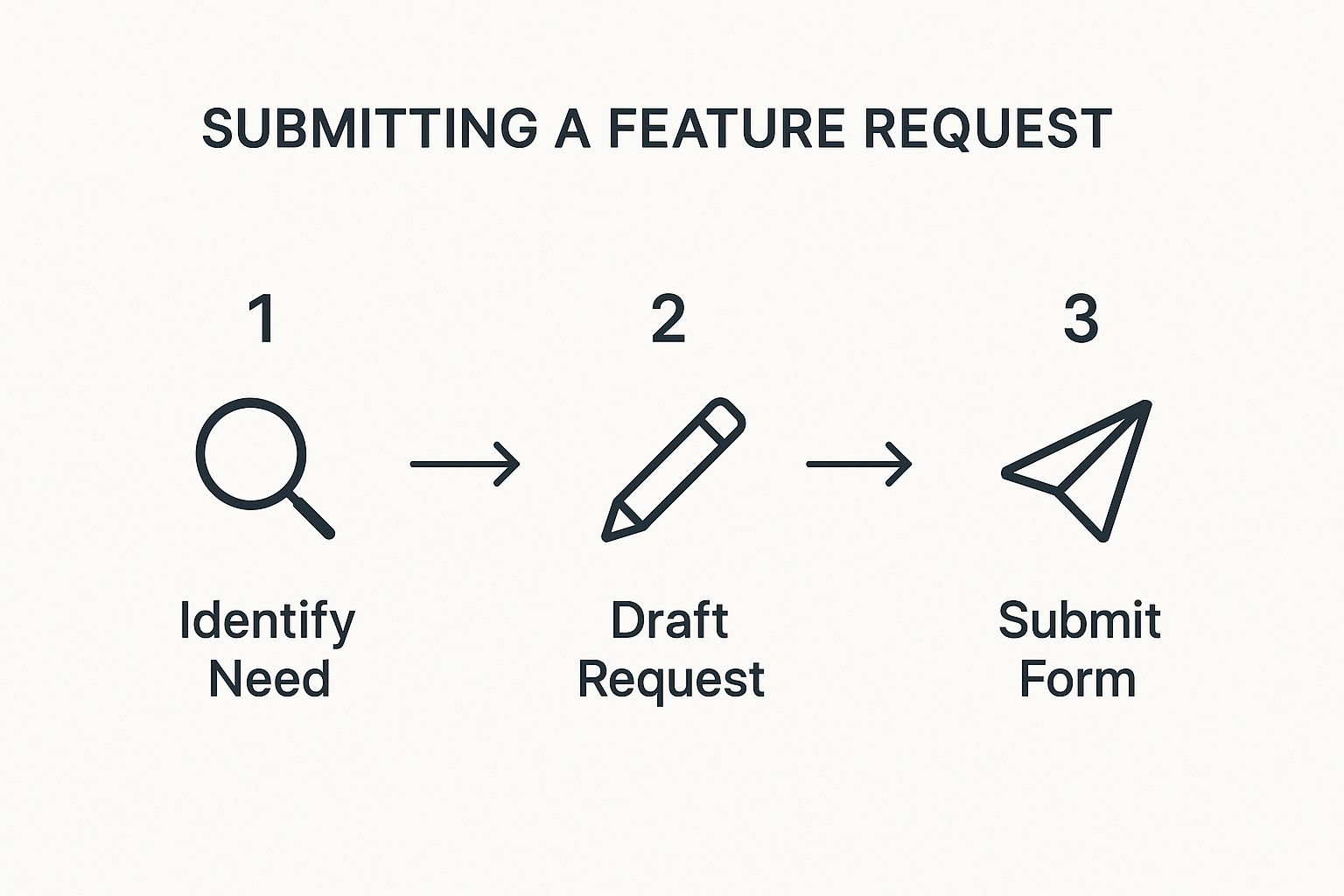How to Request a Feature and Get Noticed
Learn how to request a feature that product teams actually build. Our guide offers real-world advice and actionable tips to make your feedback count.

The best way to get a new feature built is to frame it as a solution to a problem, not just a personal wish. When you can clearly explain the challenge you’re up against and how it impacts your workflow, you build a powerful case for change that’s hard to ignore.
Why Your Feature Request Matters More Than You Think

Ever held back on submitting an idea because you figured it would just vanish into a digital black hole? It’s a common thought, but the truth is, your feedback is one of the most valuable assets a product team has. A well-written feature request is so much more than a simple suggestion—it's a critical piece of data that drives real improvement.
Turning Feedback into Fuel for Innovation
Your insights are a direct window into the day-to-day challenges real people are facing with a product. That ground-level perspective is gold for product managers who are constantly juggling priorities. When you clearly articulate a problem, you help them spot patterns and understand pain points that raw analytics could never reveal.
From the company's side, analyzing and managing these requests is essential for keeping the product aligned with what users actually want. This ultimately boosts customer satisfaction and loyalty. By seeing which features are in high demand, they can put their development resources where they'll make the biggest difference. There are great insights on how to manage this process on platforms like Savio.io.
The Strategic Value of Your Voice
At the end of the day, your feedback helps companies make smarter, more informed decisions. It pushes teams to move beyond their own assumptions and build things that solve genuine problems. A single, well-articulated request often speaks for the unspoken frustrations of hundreds of other users.
This whole process is a cornerstone of smart product development, helping teams:
- Prioritize the Roadmap: Your input directly influences what gets built next based on real-world needs.
- Allocate Resources: It ensures engineering time is spent on features that deliver the most value.
- Drive Innovation: User feedback is often the spark for the next big thing or a game-changing improvement.
By learning how to communicate your needs effectively, you take an active role in shaping the tools you depend on. For more context on this, it's worth taking a deeper dive into how to understand customer needs.
Laying the Groundwork Before You Write Anything

A great feature request doesn't just appear out of thin air. It starts with a bit of homework. Before you even start typing, a little prep work can make a world of difference in getting your idea noticed and, more importantly, acted on by the product team.
First things first, play detective. Dig around the product for a bit. Check the settings, browse the help articles, and skim the documentation to make sure the feature you want doesn't already exist. You'd be surprised how often a powerful capability is just tucked away in a menu you haven't explored yet.
Search Before You Suggest
So, you've confirmed the feature is definitely missing. Great. Your next stop should be the community forum or the existing feedback portal. Chances are, you're not the first person to run into this particular problem, and someone else may have already put in a similar request.
Finding a pre-existing request is actually a good thing! Instead of starting a new ticket, you can piggyback on their work and make the request even stronger.
- Upvote it! This is the easiest way to bump its priority.
- Add your two cents. Drop a comment explaining your specific situation or use case. This adds valuable context and strengthens the original post.
- Follow the thread. Subscribing for updates means you’ll know the second the team looks at it.
This approach works because it consolidates feedback. It’s much more effective than creating a duplicate request that splinters the conversation and makes the demand seem smaller than it is. Companies rely on these signals as a key part of their voice of customer analysis to figure out what to build next.
Gather Your Evidence
Alright, last step. Get your examples ready. Product managers live and breathe real-world context; they need to understand the impact of the problem you're trying to solve. A vague suggestion like "the dashboard should be better" gives them nothing to work with.
This kind of evidence turns your personal opinion into a compelling, data-driven case study that a product team can sink their teeth into. To learn more, check out these effective strategies for gathering customer feedback.
How to Frame a Feature Request That Gets Noticed
Want to turn your great idea into a feature that actually gets built? The secret is a simple but powerful shift in perspective. Stop focusing on what you want the product to do and start framing it around the problem it solves.
This single change makes all the difference. It helps product managers immediately grasp the value and gives them a reason to champion your request.
Start with a Title That Tells a Story
Your title is the first thing a product manager sees. Vague titles like "Dashboard Improvement" or "New Report" are dead on arrival—they just blend into the noise.
You have to be specific and outcome-focused. Instead of "Dashboard Improvement," try something like: "Add 'Customer Health Score' Column to Main Dashboard to Proactively Flag Churn Risk." See the difference? That title immediately tells the product team who it's for, what it does, and why it matters.
Don't Just State the Problem—Make Them Feel It
Once you have their attention with a great title, your next move is to detail the problem. Resist the urge to jump straight into your proposed solution. First, you need to describe the pain point you’re experiencing.
Walk them through the frustrating or inefficient workflow you're currently stuck with. Paint a clear picture.
For instance, you could say: "To identify at-risk customers, I have to open three different reports and manually cross-reference the data. This takes about 20 minutes per account. Because it’s so time-consuming, I can only review my top 10 accounts each day, which means other struggling customers are flying completely under the radar."
That kind of real-world story is infinitely more compelling than just saying, "I need a better report."
This simple flow helps visualize how to turn that pain point into a structured request.

Breaking it down this way ensures you cover all your bases before you hit "submit."
Connect Your Problem to Business Impact
Okay, you've described the problem. Now, you need to connect it to what the business actually cares about: time, money, and risk. This is where you really grab a product manager's attention.
Quantify the impact whenever you can:
- Time Wasted: "Our team collectively loses about 10 hours per week on this manual workaround."
- Lost Revenue: "We believe we lost two deals last quarter because we couldn't generate the necessary forecast report fast enough for the client."
- Increased Risk: "The current manual process is prone to human error, which could lead to inaccurate data in our quarterly financial reports."
For a quick cheat sheet, I've put together a table of what works and what doesn't when you're writing these requests.
Feature Request Dos and Don'ts
| Do This | Don't Do This |
|---|---|
| Focus on the "why" before the "what." | Jump straight to describing your solution. |
| Write a specific, outcome-driven title. | Use vague titles like "New Feature" or "UI Fix." |
| Quantify the business impact with numbers. | Make generic claims like "this will improve things." |
| Provide a real-world user scenario. | Assume the reader understands your daily workflow. |
| Clearly state the desired outcome. | Leave the end goal open to interpretation. |
Keeping these points in mind will put your request leagues ahead of the average submission.
It’s also helpful to know that most requests fall into three buckets: a bug fix, a new feature, or an improvement to an existing one. While brand-new features can be exciting, don't underestimate the power of a well-argued improvement. Showing how a small tweak can reduce risk or save money is a fantastic tactic that aligns perfectly with core product management strategies. For a deeper dive, see how other product teams manage feature requests on ProdCamp.com.
Ultimately, when you frame your request around solving a painful and expensive problem, it’s no longer just a suggestion. It becomes a compelling business case.
Submitting Your Request Through the Right Channels

You've put in the work and crafted a brilliant feature request. But where you send it matters just as much as what's in it. Sending it to the wrong place is like shouting into the void—it’s just not going to be heard by the people who can make it happen.
Tossing a request into a tweet or a generic support ticket might feel like you're doing something, but those messages rarely find their way to the product team. They get lost in the noise. To make a real impact, you need to use the official channels they’ve set up for exactly this purpose.
Locating the Official Feedback Hub
So, where do you find this magical portal? Most companies that value feedback make it pretty easy to find. Your first stop should be the application’s help menu or the website footer.
Look for links with straightforward labels like:
- "Feedback" or "Suggest a Feature"
- "Community Forum"
- "Product Roadmap"
- "Contact Us" (but be sure to look for a product-specific option)
Using these designated routes ensures your idea gets logged, categorized, and funneled directly to the product managers and developers from the get-go.
Many forward-thinking companies use specialized software to manage all this incoming feedback. These tools are a game-changer, helping product managers organize ideas, gauge potential impact, and keep users in the loop. It’s a huge win for transparency. If you're curious, you can find more details about how these feature request tools work on FeedBear.com.
Once you've submitted your idea, the next step is to track its journey. Keep an eye out for status updates like "Under Review" or "Planned"—these are great signs that your idea is gaining traction. It’s perfectly fine to add a polite comment if you have new information or context, but try to avoid constantly pinging the team for updates. Trusting their process helps keep your relationship positive and your feedback constructive.
What Happens After You Click Submit
So you’ve hit the “Submit” button on your feature request. It might feel like you’ve just launched your idea into a black hole, but that click is actually the first step in a surprisingly detailed journey. Your request has just landed in the product team’s triage system—their central hub for every piece of feedback that comes in.
This is where the initial sorting happens. Think of a product manager as an ER doc for feedback. They're quickly assessing each new request, spotting duplicates, and grouping similar ideas together. This initial pass helps them see the bigger picture. Is this a one-off thought, or are you the tenth person this week to point out the same problem?
The Prioritization Puzzle
Once it's been triaged, your idea moves into a much tougher evaluation. Product teams have to be incredibly deliberate about what they build next, so they weigh every request against a pretty demanding set of criteria.
They’re asking some hard questions to figure out what moves forward:
- Strategic Alignment: Does this actually fit with where we're trying to take the product in the long run?
- User Impact: How many people are asking for this? And for those who are, how much of a headache is this problem causing them?
- Engineering Effort: What will it really take to build this? Are we talking about a few days of work or a massive, multi-quarter project?
After you submit your request, it officially enters the product roadmap process. Here, a well-defined feature prioritization framework is used to figure out what gets built and when. This structured approach is essential for making smart, objective decisions instead of just chasing the newest shiny object.
Knowing what happens behind the scenes helps set realistic expectations. A fantastic idea might get put on the back burner simply because it doesn't line up with the current strategic goals, or because a more urgent, high-impact project just jumped to the front of the line. It's a constant balancing act between solving today's problems and building for the future.
Got Questions About Your Feature Request? We've Got Answers.
Submitting an idea is exciting, but then the waiting game begins. It's natural to have questions about what happens next. Let's walk through some of the most common things people wonder about after they hit "submit."
How Long Does This Usually Take?
Honestly, it can vary a lot. You might hear back in a few days, or it could be a couple of months. It really depends on the size of the product team and how many suggestions they're juggling at any given moment.
You should get an automated email pretty much right away confirming they received your idea. That's your cue that it's officially in their system. A real, human response or a status update will take longer while the team figures out where your idea fits into the bigger picture. The best thing you can do is keep an eye on the tracking system they provide and trust the process. Bombarding them with follow-up emails usually just creates more noise for them to sift through.
What if They Say No?
First things first: don't take it personally. When a request is marked as "rejected" or "closed," it's not a critique of your idea. It’s a business decision based on their current priorities and resources.
Read their feedback. It’s gold. You can often use their reasoning to rethink your suggestion. A small adjustment to your original idea could be all it takes to resubmit something that perfectly aligns with their goals.
Should I Submit One Big Request or Break It Up?
This one's easy: always submit one distinct idea per feature request.
Product teams need to track and prioritize every single idea on its own merits. If you bundle a bunch of unrelated suggestions into one ticket, it becomes a logistical nightmare for them to manage. The whole thing might get ignored because it's too complicated to unpack.
If you have a few ideas that are connected, submit them as separate requests. Then, just add a comment in each one linking to the others to show how they relate. This keeps everything clean, actionable, and much easier for the product team to work with.
Stop guessing what customers want and start knowing. SigOS transforms messy feedback into clear, revenue-driving priorities. Discover how to build the right features, faster.
Keep Reading
More insights from our blog


